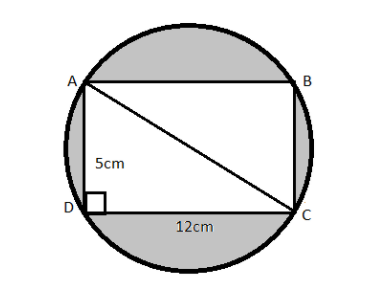
Find the area of the shaded part in the figure: (Use π=3.14)


Answer
574.8k+ views
Hint: we will find the diagonal AC, since, AC represents the diameter of the circle. The radius of the circle is half of the diameter. From the radius, we found out we will find the area of the circle shown. Also, find the area of the rectangle from the given graph.
from the subtraction of the area of the rectangle from the area of the circle, we will get the area of the shaded portion.
Given: AD= 5cm, DC= 12cm
Formulas used:
Pythagoras theorem formula; \[\text{hypotenuse}{{\text{e}}^{2}}=\text{side}_{1}^{2}+\text{side}_{2}^{2}\]
Area of circle \[=\pi {{r}^{2}}\]
Area of a rectangle \[=\text{length}\times \text{breadth}\]
Complete Step by step solution:
\[\vartriangle \text{ACD}\] is a right angled triangle.
Using Pythagoras theorem formula;
\[\begin{gathered}
& A{{C}^{2}}=A{{D}^{2}}+D{{C}^{2}} \\
& A{{C}^{2}}={{5}^{2}}+{{12}^{2}} \\
& A{{C}^{2}}=25+144 \\
& A{{C}^{2}}=169 \\
& AC=\sqrt{169} \\
& AC=\pm \,13\text{ cm} \\
\end{gathered}\]
Since AC is a length it cannot be negative therefore AC= 13cm
Through AC which is the diameter of the circle, we can find the radius of the circle. from this circle, we will find the area of the circle.
Area of the shaded region \[=\] Area of the circle \[-\] area of the rectangle ABCD
Thus, by subtracting the area of the circle with the area of the inscribed rectangle we got the area of the shaded region.
from the subtraction of the area of the rectangle from the area of the circle, we will get the area of the shaded portion.
Given: AD= 5cm, DC= 12cm
Formulas used:
Pythagoras theorem formula; \[\text{hypotenuse}{{\text{e}}^{2}}=\text{side}_{1}^{2}+\text{side}_{2}^{2}\]
Area of circle \[=\pi {{r}^{2}}\]
Area of a rectangle \[=\text{length}\times \text{breadth}\]
Complete Step by step solution:
\[\vartriangle \text{ACD}\] is a right angled triangle.
Using Pythagoras theorem formula;
\[\begin{gathered}
& A{{C}^{2}}=A{{D}^{2}}+D{{C}^{2}} \\
& A{{C}^{2}}={{5}^{2}}+{{12}^{2}} \\
& A{{C}^{2}}=25+144 \\
& A{{C}^{2}}=169 \\
& AC=\sqrt{169} \\
& AC=\pm \,13\text{ cm} \\
\end{gathered}\]
Since AC is a length it cannot be negative therefore AC= 13cm
Through AC which is the diameter of the circle, we can find the radius of the circle. from this circle, we will find the area of the circle.
Area of the shaded region \[=\] Area of the circle \[-\] area of the rectangle ABCD
Thus, by subtracting the area of the circle with the area of the inscribed rectangle we got the area of the shaded region.
Recently Updated Pages
Two men on either side of the cliff 90m height observe class 10 maths CBSE

What happens to glucose which enters nephron along class 10 biology CBSE

Cutting of the Chinese melon means A The business and class 10 social science CBSE

Write a dialogue with at least ten utterances between class 10 english CBSE

Show an aquatic food chain using the following organisms class 10 biology CBSE

A circle is inscribed in an equilateral triangle and class 10 maths CBSE

Trending doubts
Which of the following does not have a fundamental class 10 physics CBSE

State and prove the Pythagoras theorem-class-10-maths-CBSE

Differentiate between Food chain and Food web class 10 biology CBSE

State BPT theorem and prove it class 10 maths CBSE

A Gulab jamun contains sugar syrup up to about 30 of class 10 maths CBSE

Write the difference between soap and detergent class 10 chemistry CBSE




